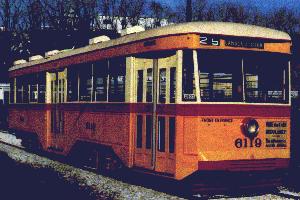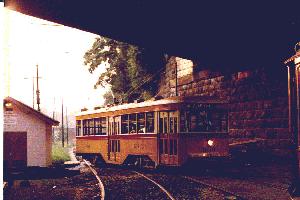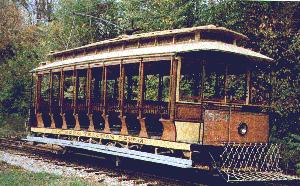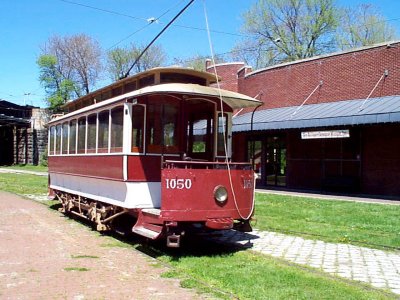 1901 Falls Road
1901 Falls Road
P.O. Box 4881
Baltimore, Maryland 21211
INFORMATION LINE: 410-547-0264
Open Year round - Sunday Noon to 5PM
Open Saturdays (June through October)
Noon - 5PM
Open Year round - Sunday Noon to 5PM
Open Saturdays (June through October)
 1901 Falls Road
1901 Falls Road
P.O. Box 4881
Baltimore, Maryland 21211
INFORMATION LINE: 410-547-0264
Noon - 5PM
 BSM's youngest car, 7407 was built by the Pullman-Standard Car Manufacturing
Company in 1944 for the Baltimore Transit Company. It was one of the last streetcars ordered for Baltimore until the MTA bought the new light rail cars. Since this car was built during the Second World War, the stanchions are painted instead of chrome coated. This car represented the height of
streetcar development in the world when it was built and has the same general performance characteristics as the modern light rail cars. This car was rebuilt in the early 1990's and is painted in its original color scheme of cream, Alexandria blue, and orange. The original paint scheme of Baltimore's PCC cars was the result of a student competition circa 1936 at the Baltimore Institute of Art.
BSM's youngest car, 7407 was built by the Pullman-Standard Car Manufacturing
Company in 1944 for the Baltimore Transit Company. It was one of the last streetcars ordered for Baltimore until the MTA bought the new light rail cars. Since this car was built during the Second World War, the stanchions are painted instead of chrome coated. This car represented the height of
streetcar development in the world when it was built and has the same general performance characteristics as the modern light rail cars. This car was rebuilt in the early 1990's and is painted in its original color scheme of cream, Alexandria blue, and orange. The original paint scheme of Baltimore's PCC cars was the result of a student competition circa 1936 at the Baltimore Institute of Art.
|

Car 1164 is a 12 bench open summer car and is one of 110 bought from the J.G. Brill Company in 1902 by the United Railways and Electric Company. This was a very popular car type with the public during the summer, since it provided one of the few ways to cool off in Baltimore during the hot summer, AC was not available when this car was in use. This car regularly ran on the 10 line, Roland Park to Highlandtown and Riverview Park, a local amusement park owned by the Transit Company. Since more than 100 of these cars were bought, the United Railways and Electric Company had to put some cars in the 1100 series of numbering.
|

Car 6119, seen at the museum's 28th street loop, is one of 150 "Baltimore" cars ordered by the United Railways and Electric Company These cars are called
Peter Witt cars after the transit designer who promoted the front entrance, center exit car with a
conductor's station located just forward of the center doors...This allowed fast loading of passengers during rush hours.
Due to the Great Depression economies, all the Witts were converted to one-man
cars. The total order of Baltimore Witts was 150, 100 from J.G. Brill and the balance from the Cincinatti Car Company. Car 6119 was built by Brill.
Restored during the 1980's, this car design was used to collect data used in designing the PCC. Although designed as a two-man car, it served its entire life in Baltimore as a one-man car.
|

Peter Witt 6119 southbound at the museum's North Ave. Loop with 264 waiting to leave for 28th street. The bridge overhead is the B&O's (CSX) main line from Baltimore to Philadelphia.
|

PCC 7407 in its last paint scheme before the end of street rail transit in
Baltimore. The picture was taken in 1960 at the Govanstown Yard.
|

Car 554 is a 9 bench open car built by the Brownell Car Company in 1896 for
the Baltimore Traction Company. This single truck car has flip over seats and pull down curtains.
|
![[ grpcars.jpg ]](images/temp/grpcars.jpg)
|

Car 1050
was built in May 1898 by the Brownell Car Company of St. Louis as
part of an order of 73 cars to replace cars that burned in the Irvington
carhouse fire of 29 May 1898. The cars were finished with cherry sashes and
interior, red Wilton carpet seat covering, and a Tuscan Red/White exterior
paint scheme. They originally were assigned to the Roland Avenue line, #10 (50 cars), and Gilmore Street, #1 (23 cars). By 1906, the cars in this order had been relegated to lighterlines. By 1911, they were the replacements for the older cars that had covered jerkwater (branchline) service. Fourteen cars were converted to one-man operation between 1916 and 1921 and served until January 1927. Another 27 cars from this order were equipped with air brakes, demotorized, and used as trailers starting in 1918. They were replaced by the 1921 Brill trailers and stored until 1926, and then scrapped.
The remaining cars were withdrawn from service and scrapped piecemeal
between 1920 and 1929. Several cars were converted to utility service,
several were placed in playgrounds, and one was renumbered 2801 and assigned
to the Safety Department, traveling the transit system displaying bulletins
for the information of motormen. It was renumbered 3651 in 1925 and
renovated for display at the 1929 Fair of the Electric Pony. It is presently
being restored to its original number.
|

Car 129
was built around 1880 by the John Stephenson Company for the
Baltimore City Passenger Railway Company. Weighing a mere 4,000 pounds,
the car probably saw its last years of service, into the early 1900's,
on the Harford Road line to Hall's Spring (near the present Argonne
Drive and Harford Road). After the car was retired from service, the
United Railways and Electric Company refurbished the car and used it for
many parades along routes with streetcar tracks.
In later years, the Baltimore Transit Company again rebuilt the car with
rubber tires so that it could be used anywhere, still with horses. The
car left the Baltimore area by the late 1940's but happily, it was
returned to the Baltimore Streetcar Museum where it is still used
occasionally for parades.
|

Gas Light Fixture
Illuminating gas was produced first as the by-product of coal
distillation in the production of tar. Its potential as an illuminant
was recognized as early as the 1790s by the English engineer, William
Murdock. In 1806-16, Murdock installed 1,000 gas lights in a Manchester
cotton mill. The first gas generating station, the London Gas Light and
Coke Company, was chartered in 1812, and by 1815, London possessed 42 km
(26 mi) of gas line that supplied illuminant for street lamps. Gas
lights came to Baltimore soon after.
The first gas burners were simple iron or brass pipes with perforated
tips, or orifices. Later, soapstone, strengthened by high temperatures,
was used as the orifice. The invention of the Welsbach mantle in the
1890s greatly increased the brightness of the gas flame, casting a
brilliant white glow.. The mantle, impregnated with cerium and thorium
compounds, became incandescent when heated by the gas flame. These were
very common in Baltimore. Gas lights were used into Baltimore until the
early 1950's. The gas light on display here shows the use of the
Welsbach mantle.
|
| BSM's Line Car | BSM Shop | Track Work |
|
Baltimore Street Car Museum Home Page |
|
Baltimore Street Car Museum Scheduled Events |